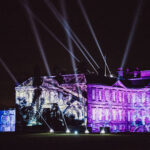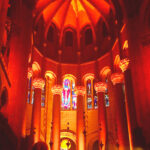
The annual pageant in Palmyra, NY at the site historically linked to the Book of Mormon is an epic production, with a prefab set and lighting towers for 740 performers.
In the minutes before the Hill Cumorah Pageant begins, cast members in full costume wander through the audience, greeting strangers with wide smiles and inviting them into conversation. Teenaged boys clad in muslin tunics with bright-colored trim, young women in muted cotton skirts with earth-toned shawls, and adults in robes appropriate for desert sandstorms readily break the fourth wall to engage with the people sitting in chairs on the wide sweep of open grass.
“Is this your first time at the pageant? Where are you from?” they ask, listening with open interest to the answers. “Wow, I hope to go there someday myself. I’m from Oregon.” Or Washington. Or Utah. Or Vancouver.
Indeed, the cast members are from everywhere: all over the U.S., parts of Canada and overseas. Carefully selected each year by the pageant’s artistic staff and elders of the Church of Jesus Christ of Latter-Day Saints, these 740 performers make the trip to Palmyra, NY, to spend six days in rehearsal and roughly two weeks performing in America’s oldest and largest outdoor theatrical production.
Here they stand on Hill Cumorah, where Latter-Day Saints congregants believe that in September 1823, young Joseph Smith received a visit from the prophet Moroni, who presented him with metal plates. The plates, inscribed nearly two millennia before by generations of historians including a man named Mormon and by Moroni himself, contained the full accounting of the stories of the Nephite and Lamanite nations that warred with one another in what would become the U.S. Smith took the plates, translated them into English, and in 1830 published them as the Book of Mormon — the book that became the bible of the Latter-Day Saints church.
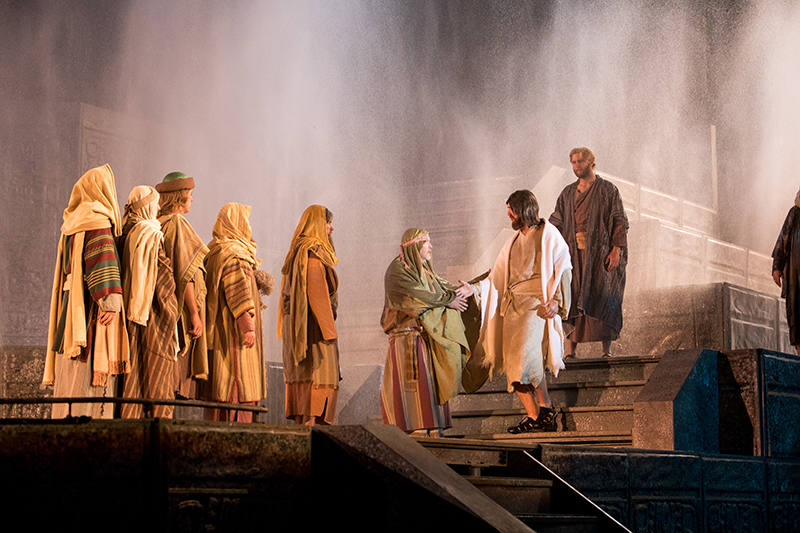
If your understanding of this religion comes entirely from the Tony Award-winning Broadway smash The Book of Mormon, or from a handful of episodes of the animated TV series “South Park,” you may find the stories woven through the 75-minute Hill Cumorah Pageant far more thoroughly and skillfully told. Award-winning author Orson Scott Card wrote the script, and whether you’ve come with an open mind for some great storytelling or with the narrowed eyes of a secular skeptic, you’ve got to marvel at how quickly the time passes. There are familiar themes of prophesy, fulfillment, betrayal and redemption, and even the construction of a great ship … which sails to ancient North America hundreds of years before the birth of Jesus Christ.
Here in America, the prophet Samuel tells of the coming of the Savior to Bethlehem and to this western promised land, and the resurrected Christ pays the Nephites and the Lamanites a visit on this continent, sharing key messages of love and tolerance before ascending to his Father.
No matter what you think of the story, what makes the telling of this sweeping multi-century epic so compelling is the spectacular presentation, directed since 2004 by Brent Hanson. From the blowing of multiple golden horns by angels in white robes to the smoothly organized herd of cast members who fill the set’s seven stages, the pageant is a marvel of lighting, sound, and perfectly timed effects — and the fact that it comes together in just six days each year tells us a great deal about the unseen organizational marvel behind the scenes and in the front of house.

Theatre on the Lawn
For 11 months of the year, Hill Cumorah stands empty, a long, grassy slide with a single monument to the Angel Moroni. One Friday morning in early July, however, 28 strong young men, all 17 or 18 years old, arrive to become the pageant’s construction and stage crew — each hand-chosen from a lengthy application process.
Four of the men served on the crew the year before, so they become “district” leaders, each with six newcomers under their charge. Most of these young men have never worked on a theatrical production before, so they are ready to take direction and learn as they go — a situation that might strike fear in the hearts of traditional summer stock production managers, but that this pageant finds preferable.
On Saturday the set arrives, an extensive series of platforms, Vacuform front facings, concrete fittings and posts, each meticulously numbered and all delivered by forklift. Designed in 1988 and 1989 under the direction of Charles Metten, then a professor in the department of theatre and media arts at Brigham Young University, the staging system provided for built-in special effects as well as precision reassembly from one year to the next. Safety railings and cables around the tops of the 20-plus levels keep cast members from taking a header off the back of the stage and lighting around the edges of each platform and along stairs — all newly installed in recent years — makes movement around the stage safe and fairly easy during the production’s dramatic lighting cues.
“Everything is labeled, and every piece has a place, and it doesn’t fit anywhere else,” says Joe Fox, pageant technical director. Fox received his first position on the pageant in 2002 and has served as technical director for five years; during the rest of the year, he works as a lighting designer and technical director and as a scenic carpenter at a Utah university.
Before Fox’s tenure, stage crew members often climbed the set like a jungle gym during the set-up, but Fox puts safety before speed at every juncture. “We’ve changed our setup model so we’re using a man lift more than we have before,” he says. “No more young men climbing like monkeys on the bars. We still get to completion on time, by end of day Tuesday, so they can focus lights on Wednesday.”
On Wednesday, lighting designer Danielle Brown’s light plot gets hung and focused by the same crew, all of it installed on 12 towers — six on either side of the hill. With no roof or grid over the stage, there are no other lighting positions, but there’s no shortage of lights for this massive pageant.
“We own all the lights, and they come here on two semis from Utah,” where another of the Church’s five pageants takes place, says Kent Reid, pageant master electrician. The pageant season begins each year on Easter in Mesa, AZ then moves on to Manti, UT, Palmyra, NY and Navoo, IL, where another Latter-Day Saints colony began after Smith led his church out of New York. Then finally it moves to Castle Dale, UT by the end of the summer.
In all, the inventory contains 477 lighting fixtures, including 32 new ETC Source Four LED products added in 2018. The lights on the towers include conventional 5°, 10°, 19° and 26° ellipsoidals with scrollers. “They’re all ETC products, including the Ion Xe console,” Reid says. Twelve Lycian spotlights complete the package. All of the lights patch into CD80 dimmer packs, an older technology that is nonetheless weatherproof — a more important factor to this production than shiny new equipment.
Even with a crew of 28, it takes four nights to focus all of these lights, especially when it doesn’t get dark enough to focus until nearly 9 p.m. Brown, assisted by Matt Georgeson, arrives for the first run-through to edit her design, the original version of which she supplied back in 2009.
“Danielle sits at the console and makes corrections,” at a tech table under a tent toward the rear of the temporary seating, noted Reid. “She does live notes during rehearsals and even performances at some times. We’ll be doing notes the last night of the show for the following year.”
This is a particularly tricky process, because the board runs automatically by timecode, synchronized with the soundtrack. The Ion Xe runs as a slave to a DMX console in an office housed in a semi tractor trailer near the stage. “So if our console goes down, that console takes over and runs the show,” says Fox. “Once the keypad on the Ion wouldn’t work, none of the faders would work — we couldn’t edit cues or use the submasters. Danielle had to do all of her editing blind from the semi.”
No words are actually spoken onstage, as the music (composed by Crawford Gates, former music director of both the Beloit-Jamesville and Rockford symphonies in Illinois and Wisconsin) and script are all pre-recorded, so actors lip-sync their lines. Followspots, however, run live and require nightly direction. “Matt, the assistant lighting designer, is on a closed headset system with the 12 followspot operators in the towers,” says Reid.
“We originally did the show with a tape and embedded time code, but a couple of years ago we moved to a CueLab digital system,” says Reid. This system still can be fallible, however. “We learned in rehearsals that we could get out of sync. We once ran the first few minutes of the show, did some things manually and saw it getting worse and worse. This was in live performance, so we had to pause the show. We waited until we only had one actor on stage, and the ground crew told him to freeze. We fixed the sync problem and started back up.”
Fox notes with pride that that was “the one and only time we had a problem that the audience could actually notice.”
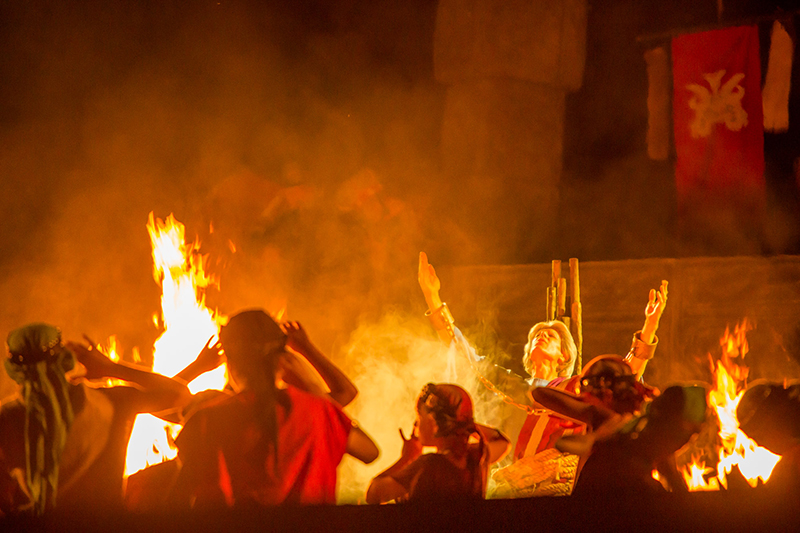
Fire, Flood and Fog
In biblical times — whatever the bible — cataclysmic events take place on a regular basis. Storms turn ships into wave-tossed toys. Infidels and uncooperative prophets get burned at the stake. People and events mysteriously appear in clouds of mist and fog. Sometimes, aquifers flow so people can be baptized.
The pageant achieves these effects with systems built into the set back in 1988, all of them designed by Rick Josephson and invisible to the audience until a water curtain begins to pour while fog rises from the floor. As fog and water commingle, the resulting effect alerts the audience that someone or something ethereal is about to happen. “This is a new effect this year behind the Savior as he enters, a curved water curtain with vapor behind it, lit by five LEDs,” says Fox. “We front-load the fog so it rises and fills in the jets. It’s so very smooth and cloudy. I told Kent I just wasn’t feeling the water, but he and I compromised and did both fog and water, and it works.” The fog effects are all made utilizing Rosco Vapour Plus machines.
On one stage, as a benevolent teacher brings people to God through baptism, waterfalls begin to pour down the walls.
“The deck is fiber grating, so it’s porous,” says Fox. “We don’t have to worry about the floor getting slippery for entering cast members.”
A water reclamation system built into the set gathers the runoff from the waterfall and other water effects, and channels it back into buckets for reuse. “We do our best to recapture the water, depending on the wind,” Reid says.
When prophet Abinadi warns a Nephite king that his people must live righteously to prepare for the coming of Jesus Christ, the king does what so many might do rather than change his lifestyle: He orders the prophet burned at the stake. In an instant, a ring of fire surrounds Abinadi, the flames rising four or five feet high around him.
“The fire is all propane-based, run by our crew of young men,” says Fox. “The flames are actually 15 feet in front of Abinadi, and there’s a wall of smoke behind him.”
With the fog and water effects run by DMX show control, staff members have suggested running the fire effects this way as well — but Fox will have none of it. “That won’t happen as long as I’m here,” he says. “We have had incidents during rehearsals where we say ‘Go,’ and the crew says, ‘Someone is standing on top of the effect.’ So we say, ‘Okay, don’t go.’ Theatre is a dangerous business. We’re always trying to improve our safety protocols.”
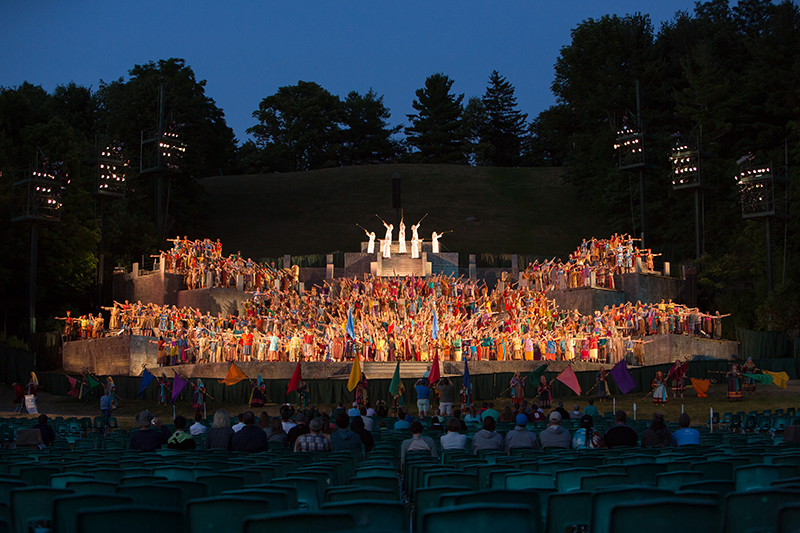
The Savior Lift
The effect that draws gasps from the audience at every performance, however, is the entrance of the Savior Jesus Christ. Appearing out of nowhere 25 feet above the stage, he glows in his white robe as he slowly descends to the highest point of the set, his arms outstretched, seemingly with no supports of any kind. Only empty sky hangs over his head, so there can be no ropes or harnesses. He drifts slowly downward to the very top of the pageant set, where he descends further on a flight of stairs to the stage floor.
Savvy theatre technology experts like PLSN’s readers know what’s happening, of course: The Savior is standing on a lift, made completely invisible by the 10 p.m. darkness and the distraction of Christ’s bright white robe — itself made virtually blinding when several pure white spotlights focus on it.
The device below him is a ribbon lift, manufactured by Actua Systems (now Will-Burt), with three flat steel coils that have interlocking teeth, much like a zipper. “The skirt of his costume is lined in black,” says Fox, “so he holds his skirt over his head and he gets an assist up to the lift.”
Two stagehands guide the actor onto the platform, hook him into a safety harness and raise him on the lift as much as 30 feet above the stage. Meanwhile, a battle scene takes place in front of him, completely masking this activity.
“On cue, he drops the skirt, just as the spots hit him,” Fox says. “It’s almost foolproof.”
As the Savior appears, the head of the flight crew and two other crew members stand below with the lift controls and a dead man switch, to start the gentle descent. “All three have to be engaged for it to go,” says Fox.
On occasion, the lift has refused to go up, but the crew has a plan B. “The lift doesn’t like moisture,” Fox says, “so we walk the Savior to the top step, and he appears and walks down the steps from there. It’s not as dramatic, but it doesn’t ruin the show.”
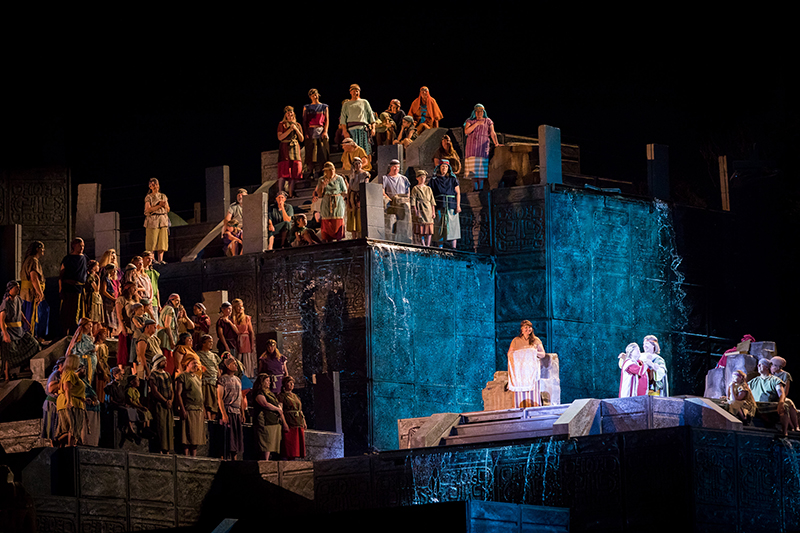
What Can Possibly Go Wrong?
In all the years that Fox has served the pageant, he’s only had to cancel the show twice for weather. “If there’s weather moving in, you’ll see me sitting out here with seven different weather apps on my phone, as well as lightning trackers. I have a window — I will call it if we can’t go. But it almost never happens.”
A lightning storm did hit once shortly before a performance, Reid reminded him. “One of the lighting towers went completely out,” he says. “We ran some extra cables and got it back up in a few minutes. The show went on.”
There’s a lightning storm on stage, too, as the great ship crosses the ocean on its way to North America. Here the pageant uses one of the lowest tech solutions in its bag of tricks: the lightning flashes are actual flashbulbs, the kind used in the 1950s. “They used to be pyro, but after 9/11, we switched to electrical so we weren’t transporting pounds of explosives in semis over state lines,” says Fox.
“As long as we can keep finding these bulbs, we’ll be fine,” adds Reid.
So the pageant expects to continue for many, many summers to come, seating as many as 5,000 people nightly for seven nights in a rural community outside of Rochester. The town of Palmyra transforms completely for two weeks in July, and then the lights go back on the trucks, the set disassembles like an erector set and goes into storage, and the grass on Hill Cumorah springs back to life, as if nothing has happened here at all since 1823.
